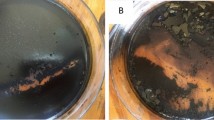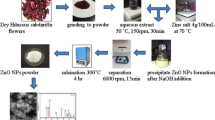Abstract
Background
Green synthesis is a simple, inexpensive, and highly efficient method for the preparation of nanoparticles. In this study, ethanol extracts of Homalothecium sericeum (HOM) moss were used as reducing agents for the synthesis of biocompatible ruthenium nanoparticles (RuNPs). The ruthenium-based green synthesis method has not been used in any other work in the literature. UV–visible spectrophotometer (UV–Vis), Zetasizer, FTIR, and EDX-SEM were used to characterize the RuNPs synthesized by the green synthesis method, and their efficacy on cell viability was tested on HCT116 human colon cancer cells.
Methods
UV spectroscopic measurements were used to study the release of HOM-RuNPs. Apoptosis was assessed by measuring protein expression of p53, Bax, and Bcl-2 by Western blotting. The presence of apoptosis was confirmed by double staining with Hoechst dye/propidium iodide under a fluorescence microscope. HOM-RuNPs were also tested for BCRP/ABCG2 expression to check for drug resistance.
Results
HOM-RuNPs with a size of 70–80 nm were found to be most effective at a dosage of 5.71 µg/ml and induced cell death by increasing the ratio of Bax/Bcl-2 and p53 expression. It was also shown to reduce multidrug resistance protein (ABCG2), suggesting that it may be useful against multidrug resistance.
Conclusion
Ruthenium-based nanoparticles synthesized by a green synthesis technique may be a candidate for anticancer drugs in the pharmaceutical industry and deserve further attention for proof-of-concept studies.










Similar content being viewed by others
Data Availability
All our experimental data are found in GraphPad Prism Programme.
References
Siegel RL, Miller KD, Jemal A. Cancer statistics, 2017. CA Cancer J Clin Wiley. 2017;67:7–30.
Dekker E, Tanis PJ, Vleugels JLA, Kasi PM, Wallace MB. Colorectal cancer. Lancet [Internet]. Lancet. 2019;394:1467–80. Available from: https://pubmed.ncbi.nlm.nih.gov/31631858/.
Grewal S, Oosterling SJ, van Egmond M. Surgery for colorectal cancer: a trigger for liver metastases development? New ınsights into the underlying mechanisms. Biomed. 2021;9:177. Multidisciplinary Digital Publishing Institute. Available from: https://www.mdpi.com/2227-9059/9/2/177/htm.
Knowles G, Haigh R, McLean C, Phillips HA, Dunlop MG, Din FVN. Long term effect of surgery and radiotherapy for colorectal cancer on defecatory function and quality of life. Eur J Oncol Nurs. 2013;17:570–7. Available from: https://pubmed.ncbi.nlm.nih.gov/23453570/.
Malki A, Elruz RA, Gupta I, Allouch A, Vranic S, al Moustafa AE. Molecular mechanisms of colon cancer progression and metastasis: recent ınsights and advancements. Int J Mol Sci 2020;22:1–24. Available from: https://pubmed.ncbi.nlm.nih.gov/33374459/.
Gopal YNV, Jayaraju D, Kondapi AK. Inhibition of topoisomerase II catalytic activity by two ruthenium compounds: a ligand-dependent mode of action. Biochem. 1999;38:4382–8. Available from: https://pubmed.ncbi.nlm.nih.gov/10194357/.
Kostova I. Ruthenium complexes as anticancer agents. Curr Med Chem. 2006;13:1085–107. Available from: https://pubmed.ncbi.nlm.nih.gov/16611086/.
Santamaria R, Irace C, Montesarchio D, Paduano L, Professor A. Perspectives and potential applications of ruthenium-based nanocarriers for cancer therapy. J Pharm Drug Dev. Annex Publishers. 2013;1:1. Available from: www.annexpublishers.com.
Blunden BM, Stenzel MH. Incorporating ruthenium into advanced drug delivery carriers – an innovative generation of chemotherapeutics. J Chem Technol Biotechnol. John Wiley & Sons, Ltd. 2015;90:1177–95. Available from: https://onlinelibrary.wiley.com/doi/full/10.1002/jctb.4507
Huang S, Liang Y, Huang C, Su W, Lei X, Liu Y, et al. Systematical investigation of binding interaction between novel ruthenium(II) arene complex with curcumin analogs and ctDNA. Luminescence. John Wiley & Sons, Ltd. 2016;31:1384–94. Available from: https://doi.org/10.1002/bio.3119.
Xu Z, Huang J, Kong D, Yang Y, Guo L, Jia X, et al. Potent half-sandwich Ru(II) N^N (aryl-BIAN) complexes: lysosome-mediated apoptosis, in vitro and in vivo anticancer activities. Eur J Med Chem. 2020;207. Available from: https://pubmed.ncbi.nlm.nih.gov/32882612/.
Tarasenko NV, Butsen AV, Nevar EA, Savastenko NA. Synthesis of nanosized particles during laser ablation of gold in water. Appl Surf Sci. North-Holland. 2006;252:4439–44.
Korbekandi H, Iravani S, Abbasi S. Production of nanoparticles using organisms. [Internet]. Taylor & Francis. 2009;29:279–306. Available from: https://doi.org/10.3109/07388550903062462.
Razavi M, Salahinejad E, Fahmy M, Yazdimamaghani M, Vashaee D, Tayebi L. Green chemical and biological synthesis of nanoparticles and their biomedical applications. Green Processes for Nanotechnology: From Inorganic to Bioinspired Nanomaterials [Internet]. Springer International Publishing. 2015;207–35. Available from: https://doi.org/10.1007/978-3-319-15461-9_7.
Hussain I, Singh NB, Singh A, Singh H, Singh SC. Green synthesis of nanoparticles and its potential application. Biotechnol Lett [Internet]. Springer Netherlands. 2016;38:545–60. Available from: https://doi.org/10.1007/s10529-015-2026-7.
Narayanan KB, Sakthivel N. Green synthesis of biogenic metal nanoparticles by terrestrial and aquatic phototrophic and heterotrophic eukaryotes and biocompatible agents. Adv Colloid Interface Sci Elsevier. 2011;169:59–79.
Mittal AK, Chisti Y, Banerjee UC. Synthesis of metallic nanoparticles using plant extracts. Biotechnol Adv Elsevier. 2013;31:346–56.
Singh SO. Invitation for book chapter on bryophytes view project. Article in Int J Pharm Sci Rev Res. 2013;23:28–35. Available from: www.globalresearchonline.net.
Özerkan D, Erol A, Altuner EM, Canlı K, Kuruca DS. Some bryophytes trigger cytotoxicity of stem cell-like population in 5-fluorouracil resistant colon cancer cells. Taylor & Francis. 2021;74:1012–22. Available from: https://doi.org/10.1080/01635581.2021.1933098.
Oztopcu-Vatan P, Savaroglu F, Filik-Iscen C, Kabadere S, Ilhan S, Uyar R. Antimicrobial and Antiproliferative Activities of Homalothecium Sericeum (Hedw.) Schimp. EXTRACTS.
Gür M, Verep D, Güney K, Güder A, Murat Altuner E. Determination of some flavonoids and antimicrobial behaviour of some plants’ extracts. Indian J Pharm Educ Res. 2023;51. Available from: www.ijper.org.
Orellana EA, Kasinski AL. Sulforhodamine B (SRB) Assay in cell culture to ınvestigate cell proliferation. Bio Protoc [Internet]. NIH Public Access; 2016 [cited 2022 Dec 12];6. Available from: https://pmc/articles/PMC5448418/.
Joshi PS, Sutrave DS. A comparative study of structural and morphological properties of pristine and Mn doped ruthenium oxide thin films. Int J Thin Fil Sci Tec. 2017;6(2):83–6.
Chen B, Le W, Wang Y, Li Z, Wang D, Ren L, et al. Targeting negative surface charges of cancer cells by multifunctional nanoprobes. Theranostics. 2016;6:1887–98. Available from: https://pubmed.ncbi.nlm.nih.gov/27570558/.
Crowley LC, Marfell BJ, Waterhouse NJ. Analyzing cell death by nuclear staining with Hoechst 33342. Cold Spring Harb Protoc. 2016;2016. Available from: http://cshprotocols.cshlp.org/content/2016/9/pdb.prot087205.full.
Gour A, Jain NK. Advances in green synthesis of nanoparticles. [Internet]. Taylor & Francis. 2019;47:844–51. Available from: https://doi.org/10.1080/21691401.2019.1577878.
Singh A, Jain D, Upadhyay MK, Khandelwal N, Verma HN. Green synthesis of silver nanoparticles using argemone mexicana leaf extract and evaluation of their antimicrobial activities. Dig J Nanomater Biostruct. 5:483–9.
Schott O, Ferrando-Soria J, Bentama A, Stiriba SE, Pasán J, Ruiz-Pérez C, et al. Chromium(III) complexes with 2-(2′-pyridyl)imidazole: synthesis, crystal structure and magnetic properties. Inorganica Chim Acta Elsevier. 2011;376:358–66.
Thangavel P, Viswanath B, Kim S. Recent developments in the nanostructured materials functionalized with ruthenium complexes for targeted drug delivery to tumors. Int J Nanomedicine. Dove Press. 2017;12:2749. Available from: https://pmc/articles/PMC5388259/.
Aird RE, Cummings J, Ritchie AA, Muir M, Jodrell DI, Morris RE, et al. In vitro and in vivo activity and cross resistance profiles of novel ruthenium (II) organometallic arene complexes in human ovarian cancer. Br J Cance. Nature Publishing Group. 2002;86:1652. Available from: https://pmc/articles/PMC2746580/.
Ali MYS, Anuradha V, Abishek R, Yogananth N, Sheeba H. In vitro anticancer activity of green synthesis ruthenium nanoparticle from Dictyota dichotoma marine algae. NanoWorld J. United Scientific Group. 2017;03.
Kannan SK, Sundrarajan M. Green synthesis of ruthenium oxide nanoparticles: characterization and its antibacterial activity. Advanced Powder Technology Elsevier. 2015;26:1505–11.
Gopinath K, Karthika V, Gowri S, Senthilkumar V, Kumaresan S, Arumugam A. Antibacterial activity of ruthenium nanoparticles synthesized using Gloriosa superba L. leaf extract. J Nanostructure Chem. Springer Medizin. 2014;4:1–6. Available from: https://doi.org/10.1007/s40097-014-0083-4.
Karges J, Díaz-García D, Prashar S, Gómez-Ruiz S, Gasser G. Ru(II) Polypyridine complex-functionalized mesoporous silica nanoparticles as photosensitizers for cancer targeted photodynamic therapy. ACS Appl Bio Mater Am Chem Soc. 2021;4:4394–405. Available from: https://doi.org/10.1021/acsabm.1c00151.
Wu J. The enhanced permeability and retention (EPR) effect: the significance of the concept and methods to enhance ıts application. J Pers Med. 2021;11:771. Multidisciplinary Digital Publishing Institute. Available from: https://www.mdpi.com/2075-4426/11/8/771/htm.
Subhan MA, Yalamarty SSK, Filipczak N, Parveen F, Torchilin VP. Recent advances in tumor targeting via EPR effect for cancer treatment. J Pers Med. 2021;11:571. Multidisciplinary Digital Publishing Institute. Available from: https://www.mdpi.com/2075-4426/11/6/571/htm.
Dadsena S, King LE, García-Sáez AJ. Apoptosis regulation at the mitochondria membrane level. Biochimica et Biophysica Acta (BBA) - Biomembranes. Elsevier. 2021;1863:183716.
Askari N, Shafieipour S, Aghajanpour M. Role of BAX, BCL-2, and MICAL-2 genes in esophageal cancer. Res Med. 2019;43:170–6. Available from: http://pejouhesh.sbmu.ac.ir/article-1-1954-en.html.
Yang T-T, Namba H, Hara T, Takmura N, Nagayama Y, Fukata S, et al. p53 induced by ionizing radiation mediates DNA end-jointing activity, but not apoptosis of thryroid cells. 1997.
Taylor NMI, Manolaridis I, Jackson SM, Kowal J, Stahlberg H, Locher KP. Structure of the human multidrug transporter ABCG2. Nature. Nature Publishing Group. 2017;546:504–9. Available from: https://europepmc.org/article/med/28554189.
Akbarzadeh A, Rezaei-Sadabady R, Davaran S, Joo SW, Zarghami N, Hanifehpour Y, et al. Liposome: classification, preparation, and applications. Nanoscale Res Lett. Springer New York LLC. 2013;8:1–9. Available from: https://doi.org/10.1186/1556-276X-8-102.
Kesharwani SS, Kaur S, Tummala H, Sangamwar AT. Overcoming multiple drug resistance in cancer using polymeric micelles. Taylor & Francis. 2018;15:1127–42. Available from: https://doi.org/10.1080/17425247.2018.1537261.
Funding
This study is supported by the project numbered 2020/B4, Istinye University.
Author information
Authors and Affiliations
Corresponding author
Ethics declarations
Conflict of Interest
The authors declare no competing interests.
Additional information
Publisher’s Note
Springer Nature remains neutral with regard to jurisdictional claims in published maps and institutional affiliations.
Rights and permissions
Springer Nature or its licensor (e.g. a society or other partner) holds exclusive rights to this article under a publishing agreement with the author(s) or other rightsholder(s); author self-archiving of the accepted manuscript version of this article is solely governed by the terms of such publishing agreement and applicable law.
About this article
Cite this article
Samir, N., Özerkan, D., Danışman-Kalındemirtaş, F. et al. Synthesis and Anticancerogenic Effect of New Generation Ruthenium-Based Nanoparticle from Homalothecium sericeum with Eco-Friendly Method. J Pharm Innov 18, 756–767 (2023). https://doi.org/10.1007/s12247-023-09725-6
Accepted:
Published:
Issue Date:
DOI: https://doi.org/10.1007/s12247-023-09725-6




